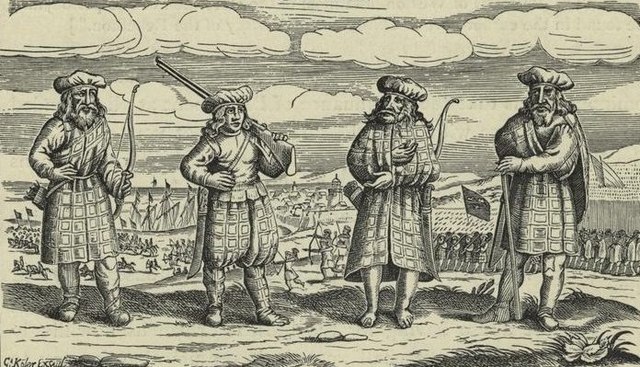Clan Mackenzie is a Scottish clan, traditionally associated with Kintail and lands in Ross-shire in the Scottish Highlands. Traditional genealogies trace the ancestors of the Mackenzie chiefs to the 12th century. However, the earliest Mackenzie chief recorded by contemporary evidence is Alexander Mackenzie of Kintail who died some time after 1471. Traditionally, during the Wars of Scottish Independence, the Mackenzies supported Robert the Bruce, but feuded with the Earls of Ross in the latter part of the 14th century. During the 15th and 16th-centuries the Mackenzies feuded with the neighboring clans of Munro and MacDonald. In the 17th century the Mackenzie chief was made Earl of Seaforth in the peerage of Scotland. During the Scottish Civil War of the 17th century the Mackenzies largely supported the Royalists. During the Jacobite rising of 1715 the chief and clan of Mackenzie supported the Jacobite cause. However, during the Jacobite rising of 1745 the clan was divided with the chief, Kenneth Mackenzie, Lord Fortrose, supporting the British-Hanoverian Government and his relative, George Mackenzie, 3rd Earl of Cromartie, supporting the Jacobites.

The earliest likeness of a Mackenzie - the effigy of Kenneth Mackenzie, 7th of Kintail (d. 1491/ 1492) located at Beauly Priory.
Commemorative stone to the Mackenzies of Seaforth on the Isle of Lewis. The Mackenzie chief's title of Earl of Seaforth took its name from Loch Seaforth between the Isles of Lewis and Harris
Clan Mackenzie tent at the 2005 Bellingham, Northumberland, England, Highland Games
A romanticised Victorian-era illustration of a Clan Mackenzie clansman by R. R. McIan from The Clans of the Scottish Highlands published in 1845.
A Scottish clan is a kinship group among the Scottish people. Clans give a sense of shared heritage and descent to members, and in modern times have an official structure recognised by the Court of the Lord Lyon, which regulates Scottish heraldry and coats of arms. Most clans have their own tartan patterns, usually dating from the 19th century, which members may incorporate into kilts or other clothing.
A romantic depiction of Highland Chiefs from 1831
Scottish soldiers, identified as of Donald Mackay, 1st Lord Reay's regiment, in service of Gustavus Adolphus (1630–31)
The Battle of Culloden, as depicted in a painting by David Morier. Modern historical thinking gives less importance to this battle as a factor in the demise of clanship.
David Wilkie's 1829 flattering portrait of the kilted King George IV, with lighting chosen to tone down the brightness of his kilt and his knees shown bare, without the pink tights he wore at the event.








